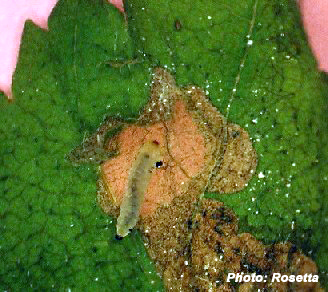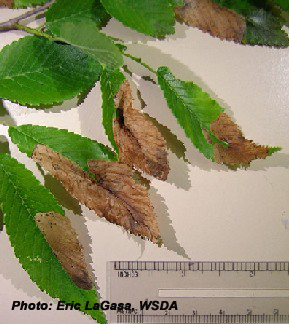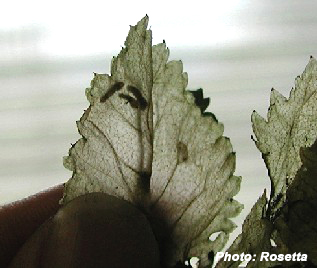
Leafminers are a problem wherever American elms, Scotch elms, Camperdown elms and English elms are located.

The elm leafminer, Fenusa ulmi, has been in the Northwest for a few years but has been noticeable in its expansion to new areas in Washington and Oregon recently.
The sawfly attacks Scotch elms, Ulmus glabra, Camperdown elms, Ulmus glabra ‘camperdownii’, Engish elm, U. procera; and American elm, U. americana (Johnson and Lyon, 1991). Scannell reported no damage on American elm in her research (Scannell, 2000).

According to research by Christine Scannell at the the University of Washington, the adult sawflies emerge coinciding with the breaking of the leaf buds of most elms, although after leaf expansion of American and European white elms (Scannell, 2000).
The timing of emergence ranged from mid-March through mid-April depending on temperatures during the course of several years of study.
The sawflies tend to emerge during the middle of the day with maximum emergence occurring between11:00 am and 1 pm. The adults are all female and begin to lay eggs immediately after emergence. The eggs are usually laid near leaf veins initially but later oviposition is without regard to location of the veins (Scannell, 2000).
There are five instars of the larvae. In 2000, the larvae were found 10 days after the first emergence of the adult sawflies (Scannell, 2000). The larvae eventually drop to the ground where they are reported to pupate through the summer, fall, and winter. There is one generation per year (Johnson and Lyon, 1991).
Read Oregon State University Alert
A Mauget Note:
Mauget tree injections has 3 GenII products and 3 liquid loadable tree injection products registered for the control of Leafminers.
They include Maugets newest insecticide Dinocide and Dinocide Hp, Imicide and Imicide Hp and Abacide2 and Abacide2 Hp.
Contact your Mauget distributor for more information.

